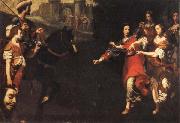Wholesale Oil Painting No Minimum |
|||||||||||
|
|
|||||||||||

|
|||||||||||
|
|
|
||||||||
Lorenzo Lippi1606-65 Italian painter and poet. He was trained by Matteo Rosselli, with whom he worked for many years in close partnership. His collaboration was sometimes anonymous but is documented from 1622, when they decorated the ceiling of the Sala della Stufa (Florence, Pitti), to 1631-2, when they worked together on lunettes portraying St Francis Adoring the Child and St Catherine in Prison (Florence, S Gaetano). In 1630 Lippi was enrolled in the Accademia del Disegno but appears not to have had his own workshop until after 1634, although he worked independently before then. The earliest paintings attributable to him are, both in facial types and in the soft, rich folds of the drapery, close in style to the work of Rosselli. Examples include canvases of the Apostles James, John and Matthew, and Christ Blessing (all 1628; Vaglia, S Pietro), and the Virgin Handing the Child to St Francis (1629; Florence, S Salvatore di Camaldoli). In the 1630s Lippi painted decorative and theatrical compositions, mainly on literary and biblical themes, which remained indebted to Rosselli, for example Samson and Delilah (1632; Stockholm, Nmus.) and the Virgin in Glory with Saints (1634; Ronta, nr Barberino di Mugello, S Michele). Shortly afterwards he produced works |
||||||||
|
|
||||||||
The Triumph of David
The Triumph of David Painting ID:: 28987 |
mk65
Oil on canvas
90 1/2x133 5/16in
Pitti,Palatine Gallery
mk65 Oil on canvas 90 1/2x133 5/16in Pitti,Palatine Gallery |
|||||||
|
|
||||||||
|
Jan Van Den Hoecke Flemish Baroque Era Painter, 1611-1651 was a Flemish Baroque painter and draughtsman. He was born and died in Antwerp. He first apprenticed with his father, the painter Gaspar van den Hoecke (1595?C1648); then worked in the studio of Peter Paul Rubens. Jan's brother Robert van den Hoecke (1622?C1668) was also a painter. The artist and his father were well known for their 1635 execution of decorations for the Arch dedicated to the Emperor Ferdinand III in Antwerp. In this collaboration, Jan painted monumental representations, as seen in his piece, Triumphal Entrance of Cardinal Prince Ferdinand of Spain, (Uffizi Gallery). Hoecke then traveled to Austria under the commission of the Emperor Ferdinand III after 1637, staying for about ten years. He also painted for Ferdinand's brother, Archduke Leopold Wilhelm of Austria (1614-C1662), including a Madonna and Child and a number of allegorical pieces. Before this he traveled to Italy and worked in Rome, which may have influenced his style some. Another piece by Hoecke is his, Hercules between Vice and Virtue, (Uffizi Gallery), which shows an influence from both Rubens, and another pupil of the master Baroque painter, Anthony van Dyck. The Triumph of David oil on panel painting attributed to Jan van den Hoecke, c. 1635, Kimbell Art Museum Date ca. 1635(1635) cyf |
||||||||
|
|
||||||||
|
Prev Next
|
||||||||
|
|
||||||||
|
Related Paintings to Jan Van Den Hoecke :. |
||||||||
|
|
||||||||
|
CONTACT US |

